Stephen Gamet, Research Technologist
Paul E. Read, Professor of Horticulture/Viticulturists
University of Nebraska Viticulture Program
Department of Agronomy and Horticulture
Vaughn Hammond, Arbor Day Foundation
According to Winkler, "grapevines cannot be grown satisfactorily without some form of support." Why is this the case? There are multiple reasons for training vines onto a trellis, including maximizing light interception, reducing labor cost, avoiding delayed bearing, minimizing disease pressure and developing a strong, straight trunk. In addition, trellised vines are out of the way of cultivation and other vineyard operations. Methods and materials required for a suitable trellis system will be presented following discussion of the reasons for training grapes onto a satisfactory support system or trellis.
Light Interception
Grapes need light in order to flower and develop into desirable grapes. All grapes will be more productive in full sun than if they are grown in shady conditions. Photosynthesis in the grape leaves result in production of sugars and other products essential to development of high quality fruit. In addition, the formation of buds essential to production of the subsequent years crops dependent on light falling on the developing canes. Many of the ways to get more sunlight to the grape plants and their clusters are by pruning, canopy management, and a north south trellis alignment. A properly constructed trellis also facilitates vine size, structure and canopy management. This makes it easy to see what parts of the vine need to be pruned and to easily see what clusters need to be removed in the cluster thinning process.
Disease Management
Grapevines are subject to a diversity of fungal diseases, most of which are more devastating under stagnant, moist air conditions. With a vine on a trellis and the proper canopy management, better airflow is established. Reducing its potential disease problems. With vines trained onto a trellis fruit is not in contact with the soil, eliminating soil borne fruit rots. With plants on a trellis it is also easier to then spray the vines and get a more thorough and even coverage. This is not only true with fungicides but also with insecticides.
Furthermore with vines trained on a trellis, the job of weed control under the plants becomes much easier. Vines maybe sprayed more effectively without the concern of herbicide damage to the vines.
Harvest
A strong, well-designed trellis facilitates harvest. Choice of a trellis system will be different for grapes that are to be machine harvested, than for those that will be picked by hand. At this time, essentially all grape vineyards in Nebraska are hand-harvested, so trellis systems appropriate for mechanized harvest are not presented in this discussion.
Materials
Now that we have established the importance of a trellis system, it is important to determine the materials. As with any type of construction, the foundation is the most important and the best starting point. End post construction of a trellis begins with the end post assembly. This is the one place you should not skimp because it can come back to haunt you later. 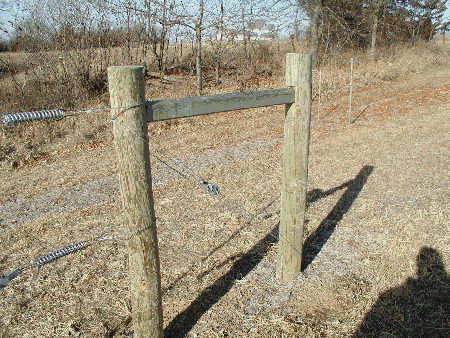
H-brace end support. Note the use of both the spring and ratchet.
There are several different types of end post construction; some standard some a little unconventional, but all functional. Most common is either the use of the H-brace system or the end post put in at a 15-degree angle from the vertical with a "dead man" or other earth anchor.
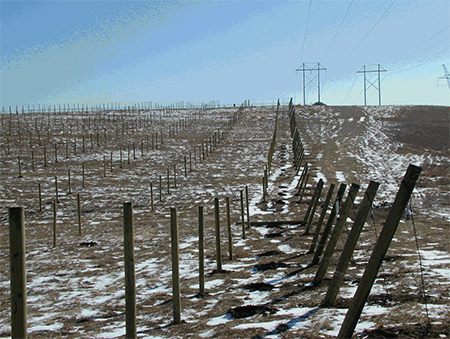
End post installed at a 15-degree angle with a "dead man" anchor.
It has been proven that end post placed at an angle in this method is no stronger than a vertical post. Soil condition is often a more critical factor in failure of end post construction than the actual material itself. It is essential that the end post assembly be of sturdy material, with some growers choosing at least an 8-inch diameter end post in either of the afore mentioned systems.
There often are other materials that maybe available to growers. Some are not economical and may prove to be too time consuming to obtain or install. Examples may be steel posts placed in concrete, concrete post, old railway line and ties or pipe from old pivot irrigation systems. If these or other options are available and economical, they will be acceptable choices. That is assuming adequate strength is combined with freedom from toxic substances to the grapevines.
Line Post
End posts provide anchors for the trellis system; line post holds it all off the ground. The two most common materials employed for line posts are landscape timbers or steel T post. Both have proven to be effective but have their drawbacks. Landscape timbers are relatively economical, but can break off and may rot off in a short period of time.
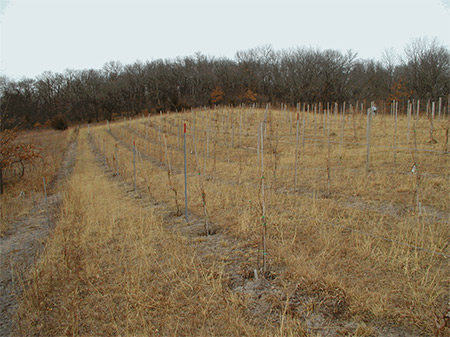
The use of steel T-Post in the vineyard.
Steel posts can bend under the heavy vine and crop weight, especially in a heavy wind. Steel posts have also been known to sink into the ground under heavy crop loads. Other materials used are fiberglass poles, 4 inch treated fence posts and well pipe. As with end posts, availability, strength and price are important considerations.
Wire
Use of high tensile, 12-gage steel wire is a must. Lighter weight wire such as that used for electric fencing is not recommended. Breakage during a heavy crop load is almost impossible to repair, and requires significant extra labor, cost and may result in serious crop loss.
Additional hardware needed include springs, ratchets, earth anchors, cross arms, wire fasteners and wire splicers. Some of these are optional while some are a must.
Tools requisite for trellis construction are fence pliers, spinning jenny, posthole digger, tamper, shovel and saw. The spinning jenny is a must. You can either dig the holes for the post or have them driven in the ground with a driver. In some vineyards posts driven into the ground have proven to be more stable than posts whose ends are placed in holes and tamped into the soil.
Matchmaking
In Nebraska, cultivars of three major grape types are being grown: American; French-American hybrids, and newer hybrids of varying parentage; and European, or V. vinifera.
The matching of a trellis system to a cultivar is dependent on the cultivar being grown. Most American and many French-American hybrid cultivars tend to have a downward, or procumbent growth habit. This type of growth habit is best trained on a trellis with a high renewal zone. Such trellis systems employ training the grape plant on to the top wire, at least 5 to 6 ft above the ground. This allows plenty of room for the vines to curtain downward and just reach the ground by the end of the growing season. Downward shoot positioning will then be necessary to reorient horizontal shoots and to prevent shading of the renewal zones along the top wire.
European, or V. vinfera cultivars on the other hand have for the most part an upright growth habit. This growth habit is best managed with an upward vertical shoot positioning. The shoots originate from a mid or low wire cordon or cane and are positioned vertically upward through a set of catch wires.
Vine Vigor
When determining trellis choice predicted vigor must also be considered. Site-specific characteristics that influence vine vigor include soil structure and climatic conditions.
A well-designed and properly constructed trellis will produce a large canopy surface area and relatively low canopy density. A good trellis system with a good canopy management system should produce a canopy that has 2-3 layers of leaves and minimal shading. This should result in a top quality crop with high sugar content.
What is the vine vigor potential of a given site? That can be difficult to determine if no previous history is available for the site. But if prior cropping history exists for the site then this could be relative easy. Whether a "track record" for the site is or is not available, it is recommended that soil samples be taken. Test results not only will provide guidance for future fertilizer practice, but also should give a rough idea of the vine vigor potential for the site. If the potential vigor is overestimated and vines are spaced too far apart, yield per acre is generally reduced. If underestimated and inadequate trellis space is provided, shading and its associated problems will occur. Making the correct choice in the first place is easier than making the corrections later on.
A Short Pruning Course
There are basically two different types of pruning: cane pruning and spur pruning. These differ only in the amount of fruiting wood you retain. Cane pruning requires that long, 10-20 node fruiting canes be retained for fruiting. Spur pruning utilizes short, 2-6 node canes for fruiting. The reason for this short overview is that training systems differ in the type of pruning required, and reference will be made to either type of pruning when explaining the different types of trellis available.
Cane or spur pruning will perform well with most cultivars. Some trellis systems will employ both types of pruning (e.g., the fan system). Other cultivars perform better when cane pruned because the buds that are 4 to 12 nodes from the base of the cane are more fruitful than the first 2 or 3 nodes. Some cultivars will have a tendency to push many secondary and tertiary buds from canes and latent buds from cordons (e.g., Seyval). Short spur (two node) pruning seems to stimulate this problem whereas long spur (6 node), or cane pruning seems to reduce this tendency. Whether you utilize cane pruning or spur pruning, the training system must effectively display the renewal zone and fruiting wood
Trellis Training Systems
The Umbrella Kniffin System maybe the most popular cane pruning system in the Midwest. This system utilizes long canes (10-20 buds each) that originate from renewal spurs at or near the top of the trunk (e.g., the head). Four to six canes are retained, bent over the top trellis wire and tied securely to the mid wire. Pruning and tying must be finished before bud swell begins to avoid damage to the tender buds during the tying process. Additional drawbacks of cane-pruned systems include the extra time and effort for tying, and difficulty in leaving extra buds to protect against damage from late spring frosts resulting in double pruning. This additional, cane pruning cannot be easily mechanized resulting in higher labor cost.
High (bilateral) Cordon and Geneva Double Curtain (GDC) are the most commonly used spur pruning systems in the Midwest. In many respects spur pruning systems are more efficient than cane pruned systems. Selection of fruiting wood is simplified and there is no laborious tying of canes. Spur pruning also allows for additional buds to help avoid late spring frost. These systems are also more readily adaptable to mechanization.
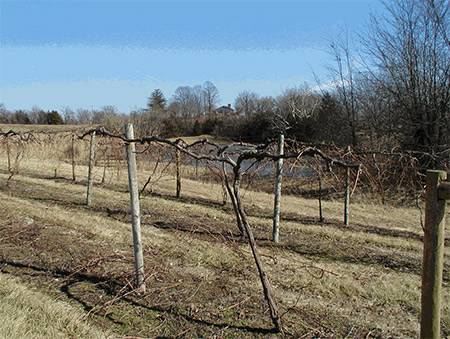
Cynthiana Norton on a High Cordon
In the High Cordon system cordons extend along the top wire of the trellis in both directions. The cordons then remain as semi-permanent extensions of the trunk, though they may need replacement every few years. Either spur pruning or cane pruning can be utilized. Fruiting spurs of 2 to 6 nodes long are spaced along this cordon with shorter renewal spurs left to provide fruiting wood for the next season. Cordons from adjacent vines extend to meet each other half way between vines so that the canopy is continuous. Down ward shoot position is employed. A High cordon system is for less aggressive vines and low vigor sites. This system is readily adaptable to mechanization.
The Geneva Double Curtain (GDC) system employs a horizontally divided canopy that is separated into two distinct canopies or "curtains". Cordon support wires are separated by cross arms that are usually 4 feet wide. Vines are generally trained as in Bilateral Cordon system with cordons of adjacent vine, providing twice as much trellis space for each vine. Occasionally each vine is trained quadrilaterally to occupy both sides of the trellis rather than alternating vines. In-row vine spacing is often reduced 20-25% from single curtain systems to assure trellis fill, but between-row spacing may need to increase to accommodate standard equipment.
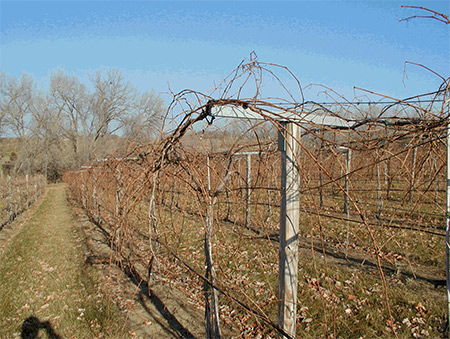
Geneva Double Curtain (GDC)
The Geneva Double Curtain system is particularly well suited to high vigor vineyards and can result in yields that are 50% higher than for single curtain systems.
European (Vitis vinifera) cultivars have an upright habit. They need a system that can accommodate this along with their lack of winter hardiness. One that both allows easy removal and replacement of trunks in case of winter injury and provides room for vertical training of shoots. Low-wire and mid-wire systems allow for easy implementation of both these requirements. Trunks can be trained on to a wire anywhere from 6 to 42 inches above the ground with cordons or canes extending along this wire. Then the upward growing shoots are then trained between pairs of catch wires on either side of the post to the top of the trellis. This system is commonly called vertical shoot positioning (VSP). After the shoots reach the top of the trellis they then can be trimmed off. This will help prevent shading of the fruit and renewal zone. If the main wire the cordons or canes are trained to is over 42 inches above the ground the trellis system maybe modified with post extensions to accommodate an adequate amount of leaf canopy to allow for proper fruit development. Extensions can also reduce labor by eliminating the amount of trimming needed when the vines reach the top of the trellis. A word of caution, if shoot trimming is done too early lateral shoot growth maybe promoted causing excessive and undesirable shading of the fruit and renewal zone. 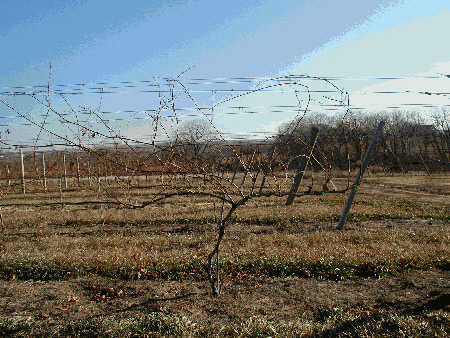
Mid-wire vertical shoot positioning (VSP).
This type of system can be labor intensive in the positioning of the shoots between the catch wires but does lend itself to mechanical harvesting. Also the use of a gas powered hedge trimmer can be utilized in the control of the vertical shoots above the trellis and in the dormant pruning.
The Fan system or multiple trunks is often used when working with cold tender cultivars. Several trunks are retained and trained on a multiple wire trellis. Older trunks tend to be more prone to winter injury than young trunks, but are also more fruitful. So the practice is to keep several trunks (3 to 5) of varying years for a continuous renewal of fruiting wood. It is not recommended to keep any trunk more than five years, with replacement trunks of four, three, two and one years old. Either spur pruning or cane pruning can be employed depending on the degree of winter injury the plant has sustained. This type of training system is open to more interpatation than others but is useful for cold tender cultivars in the Mid-west.
The U or Lyre system developed in France is a divided canopy system for upright growing cultivars. It is a horizontally divided trellis positioning the shoots in an upward direction of 10 to 15 degrees from vertical angling outward. Vines are treated, as they would be in a low or mid-wire vertical shoot positioning system. As in other divided systems vines can be alternate to opposite sides, or occupy both sides of the trellis. Because of the extensive cordon development required, this system could be difficult to maintain in areas where cold injury is common.
Two relatively new systems that have not been extensively tried in the Midwest are vertically divided canopies such as the Scott Henry and Smart-Dyson or Smart-Dyson Ballerina. There is limited experience with these systems in the Midwest so it is difficult to tell if they will be an improvement over any existing systems. There could be problems with reduced vigor and loss of winter hardiness on the downward positioned shoots. Possibly, these problems can be solved with cane pruning on the lower trellis.
Worth mentioning is the use of mechanical pruning and minimal pruning techniques. Work has been done in other parts of the country to mechanize all aspects of grape production. Training systems most commonly utilized are the high bilateral cordon or Geneva double curtain. Pruning can range from at closely approximating hand pruning to minimal skirting of canes in the lower section of the trellis.
Shoot Positioning
In most training systems shoot positioning is as important aspect. In systems that utilize spur pruning the fruiting shoots must be positioned vertically in either an upward or downward manor or in some cases both directions. The goal is to form a curtain of foliage that can maximize light interception and at the same time assure that the basal region is well exposed. This basal region is where nest years wood well being retained for that year's crop. Good light interception is critical to the quality of the "renewal zone" wood. No more than two or three leaves will need removal. Remove too many and sun exposure can cause damage to the fruit clusters. Without implementation these proper techniques of shoot positioning spur pruning may fail to meet expectations.
Growth Habits
There are basically three different types of growth habits that cultivars display, trailing or pendulous, semi-upright, and upright. Some of the more important cultivars are placed in these categories and listed below.
Trailing: Most American cultivars, Marechal Foch, Edelweiss and Saint Croix
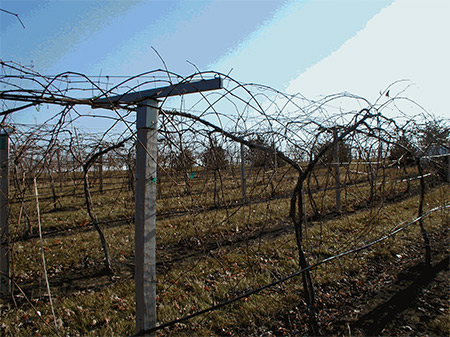
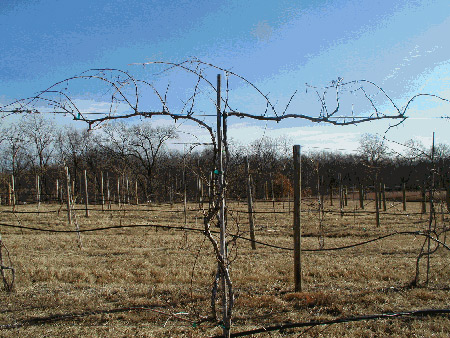
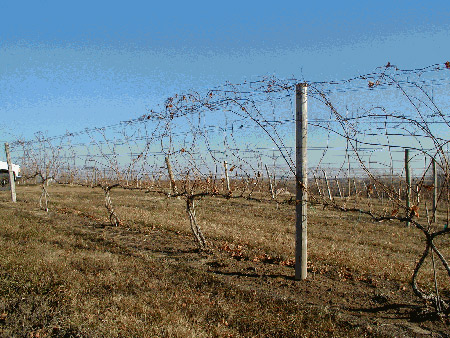
Edelweiss on GDC., deChaunac on high cordon.
Semi-upright: deChaunac, Lacrosse, Prairie Star, Vidal, Chancellor, and Chambourcin
Upright: Vinifera cultivars, Vignoles, Saint Vincent